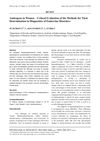TLDR Hormone levels in hair change during pregnancy, with progesterone increasing significantly compared to non-pregnant women.
The study investigated changes in cortisol, dehydroepiandrosterone (DHEA), testosterone, estradiol, and progesterone in hair across pregnancy, comparing pregnant women to a non-pregnant control group. It found that progesterone levels significantly increased in pregnant women, while DHEA levels decreased early in pregnancy. There was suggestive evidence of increases in cortisol and estradiol during pregnancy, but these changes were not significantly different from those in non-pregnant women. Testosterone levels showed little change. The study highlighted substantial individual variability in hormone changes and emphasized the importance of considering within-person trajectories and non-linear patterns in future research. Hair was noted as a useful biospecimen for capturing cumulative hormone levels over time, despite limitations such as small sample size and batch effects.
2 citations
,
April 2020 in “Clinical and experimental obstetrics & gynecology” Hair levels of estradiol and progesterone are higher in premenopausal than postmenopausal women, but the difference isn't statistically significant, indicating the need for a better measurement method.
42 citations
,
December 2019 in “Steroids” Body hair isn't a good substitute for scalp hair in steroid analysis.
237 citations
,
September 2018 in “Clinical Biochemistry” Hair cortisol analysis can help diagnose stress-related conditions but needs more refinement for widespread use.
 34 citations
,
August 2003 in “Clinical and Experimental Dermatology”
34 citations
,
August 2003 in “Clinical and Experimental Dermatology” Pregnant women's hair gets thicker.
89 citations
,
December 1998 in “The Journal of Steroid Biochemistry and Molecular Biology” Human hair can be used to measure reproductive hormones.
 24 citations
,
May 2015 in “Schizophrenia Research”
24 citations
,
May 2015 in “Schizophrenia Research” A drug improved schizophrenia-like symptoms in stressed rats by changing brain steroid levels.
 251 citations
,
October 2014 in “The Journal of Clinical Endocrinology & Metabolism”
251 citations
,
October 2014 in “The Journal of Clinical Endocrinology & Metabolism” The guidelines advise against using testosterone and DHEA in women for most conditions due to safety and effectiveness concerns, but suggest considering testosterone for postmenopausal women with low sexual desire.
 13 citations
,
June 1989 in “Pediatric clinics of North America/The Pediatric clinics of North America”
13 citations
,
June 1989 in “Pediatric clinics of North America/The Pediatric clinics of North America” The conclusion is that young women with excessive hair growth should be quickly tested for hormonal issues and treated to improve their social well-being.
 403 citations
,
November 2005 in “Journal of Endocrinology”
403 citations
,
November 2005 in “Journal of Endocrinology” Dehydroepiandrosterone (DHEA) is a prohormone important for producing sex steroids and has potential health benefits.
 10 citations
,
November 2018 in “Physiological Research”
10 citations
,
November 2018 in “Physiological Research” The conclusion is that standardizing testosterone measurement methods is essential for better diagnosis accuracy in women.






